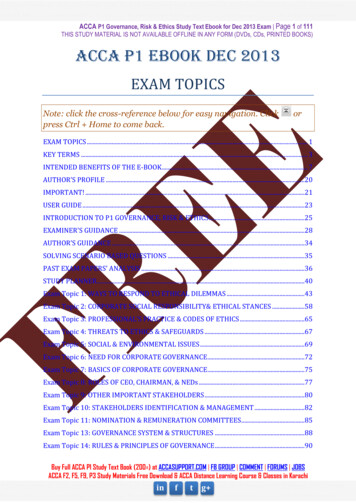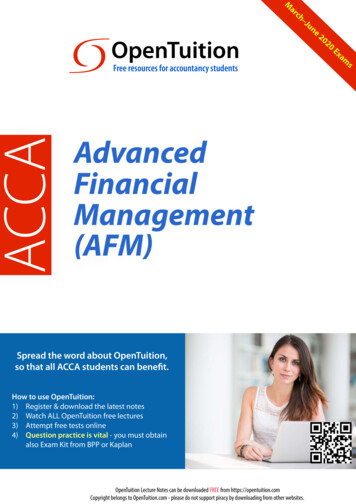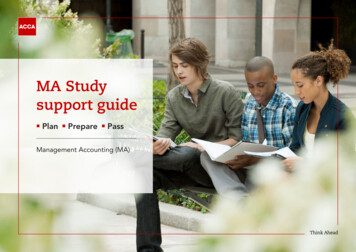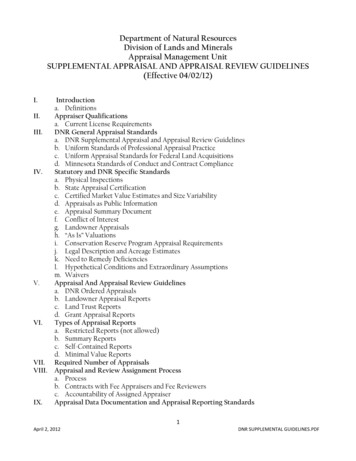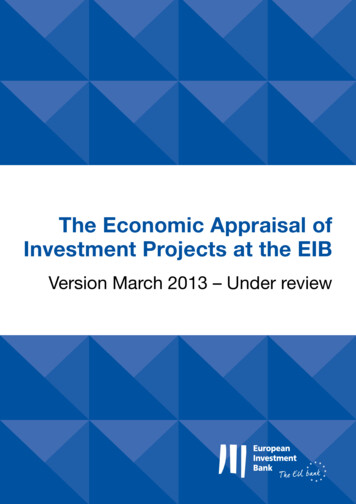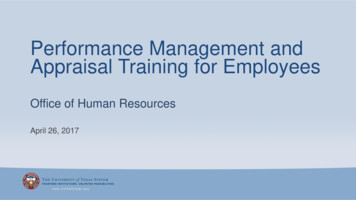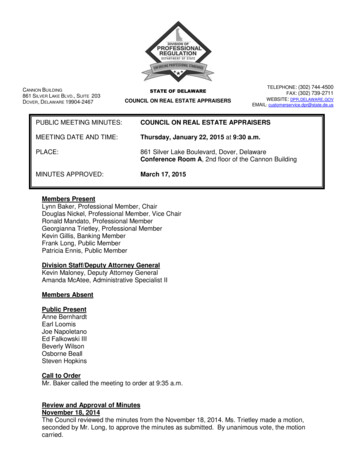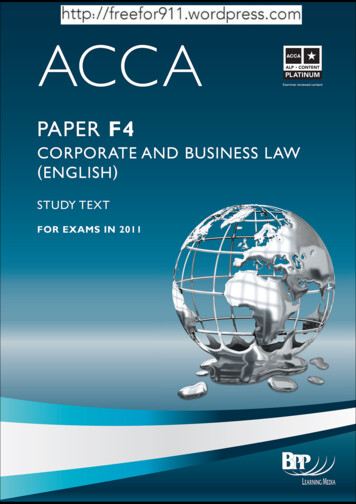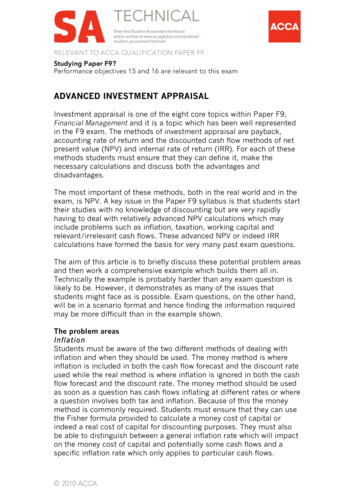
Transcription
RELEVANT TO ACCA QUALIFICATION PAPER F9Studying Paper F9?Performance objectives 15 and 16 are relevant to this examADVANCED INVESTMENT APPRAISALInvestment appraisal is one of the eight core topics within Paper F9,Financial Management and it is a topic which has been well representedin the F9 exam. The methods of investment appraisal are payback,accounting rate of return and the discounted cash flow methods of netpresent value (NPV) and internal rate of return (IRR). For each of thesemethods students must ensure that they can define it, make thenecessary calculations and discuss both the advantages anddisadvantages.The most important of these methods, both in the real world and in theexam, is NPV. A key issue in the Paper F9 syllabus is that students starttheir studies with no knowledge of discounting but are very rapidlyhaving to deal with relatively advanced NPV calculations which mayinclude problems such as inflation, taxation, working capital andrelevant/irrelevant cash flows. These advanced NPV or indeed IRRcalculations have formed the basis for very many past exam questions.The aim of this article is to briefly discuss these potential problem areasand then work a comprehensive example which builds them all in.Technically the example is probably harder than any exam question islikely to be. However, it demonstrates as many of the issues thatstudents might face as is possible. Exam questions, on the other hand,will be in a scenario format and hence finding the information requiredmay be more difficult than in the example shown.The problem areasInflationStudents must be aware of the two different methods of dealing withinflation and when they should be used. The money method is whereinflation is included in both the cash flow forecast and the discount rateused while the real method is where inflation is ignored in both the cashflow forecast and the discount rate. The money method should be usedas soon as a question has cash flows inflating at different rates or wherea question involves both tax and inflation. Because of this the moneymethod is commonly required. Students must ensure that they can usethe Fisher formula provided to calculate a money cost of capital orindeed a real cost of capital for discounting purposes. They must alsobe able to distinguish between a general inflation rate which will impacton the money cost of capital and potentially some cash flows and aspecific inflation rate which only applies to particular cash flows. 2010 ACCA
2ADVANCED INVESTMENT APPRAISALOCTOBER 2010TaxationBuilding taxation into a discounted cash flow answer involves dealingwith ‘the good the bad and the ugly’! The good news with taxation is thattax relief is often granted on the investment in assets which leads to taxsaving cash flows. The bad news is that where a project makes netrevenue cash inflows the tax authorities will want to take a share ofthem. The ugly issue is the timing of these cash flows as this is an areawhich often causes confusion.Working capitalThe key issue that must be remembered here is that an increase inworking capital is a cash outflow. If a company needs to buy moreinventories, for example, there will be a cash cost. Equally a decrease inworking capital is a cash inflow. Hence at the end of a project when theworking capital invested in that project is no longer required a cashinflow will arise. Students must recognise that it is the change inworking capital that is the cash flow. There is often concern amongststudents that the inventories purchased last year will have been soldand hence must be replaced. However, to the extent the items have beensold their cost will be reflected elsewhere in the cash flow table.Relevant/irrelevant cash flowsThis problem is rarely a big issue in Paper F9 as students have beenexamined on this topic previously. However students should rememberthe ‘Golden Rule’ which states that to be included in a cash flow tablean item must be a future, incremental cash flow. Irrelevant items to lookout for are sunk costs such as amounts already spent on research andapportioned or allocated fixed costs. Equally all financing costs shouldbe ignored as the cost of financing is accounted for in the discount rateused.Having reminded you of the potential problem areas let us now considera comprehensive example:CBS CoCBS Co is considering a new investment which would start immediatelyand last four years. The company has gathered the followinginformation:Asset cost – 160,000Annual sales are expected to be 30,000 units in Years 1 and 2 and willthen fall by 5,000 units per year in both Years 3 and 4.The selling price in first-year terms is expected to be 4.40 per unit andthis is then expected to inflate by 3% per annum. The variable costs areexpected to be 0.70 per unit in current terms and the incremental fixedcosts in the first year are expected to be 0.30 per unit in currentterms. Both of these costs are expected to inflate at 5% per annum. 2010 ACCA
3ADVANCED INVESTMENT APPRAISALOCTOBER 2010The asset is expected to have a residual value (RV) of 40,000 in moneyterms.The project will require working capital investment equal to 10% of theexpected sales revenue. This investment must be in place at the start ofeach year.Corporation tax is 30% per annum and is paid one year in arrears. 25%reducing balance writing-down allowances are available on the assetcost.General inflation is 4% and the real cost of capital is 7.7% 12,000 has already been spent on initial research.Required: Calculate the NPV of the proposed investment.Solution and explanatory notes:Many students fall into the trap of starting the cash flow table tooquickly. Initially there are a number of workings or ‘thinkings’ thatshould be carried out. These workings can generally be carried out inany order. Once they are completed it will be possible to construct thecash flow table quickly and accurately. Before going further studentsmust understand the difference between a ‘T’ and a Year. A ‘T’ is a pointin time and hence T0 is now and T1 is in one-year’s time. A Year is aperiod of time and hence Year 1 is the period between T0 and T1 andYear 2 is the period between T1 and T2. Please note T1 is both the endof Year 1 and the start of Year 2.Working 1 – InflationAs the question involves both tax and inflation and has different inflationrates the money method must be used. Hence the cash flows in the cashflow table must be inflated and the discounting should then be carriedout using a money cost of capital. As a money cost of capital is notgiven it must be calculated using the Fisher formula:(1 i) (1 0.077) x (1 0.04) 1.12Therefore, ‘i’ the moneycost of capital is 0.12 or 12%Note: The real rate (r) of 7.7% and the general inflation rate (h) of 4%must be expressed as decimals when using the Fisher formula 2010 ACCA
4ADVANCED INVESTMENT APPRAISALOCTOBER 2010Working 2 – Tax savings on the writing-down allowances (WDA)YearTWDV - ’000 Tax saving at 30% TimingAsset cost160.01 – 25% WDA(40.0)12.0T2120.02 – 25% WDA(30.0)9.0T390.03 – 25% WDA(22.5)6.8T467.54 – Balancing allowance(27.5)8.3T5Residual value40.0Notes:TWDV – Tax written down value, WDA – Writing-down allowanceThe examiner’s normal assumption is that an asset is bought at thestart of the first year of the project and hence the first WDA is availablefor Year 1.The allowance and tax saving for Year 1 will be calculated at the end ofYear 1 which is T1 and as tax is paid one year in arrears the timing ofthe cash flow will be one year later which is T2.Rounding is a key technique in your exam as it saves time and bykeeping the numbers simple fewer mistakes will be made. Here it hasbeen decided to round in thousands and use one decimal place.Students must ensure that they can calculate tax savings using differenttax regimes. For instance the next problem you face may have taxallowances granted on a straight-line basis and the tax could be payableimmediately at each year end.Working 3 – Working capital (WC)Sales WC need at ’000: 10%:Year 1 – 30 x 4.4 132.013.2Year 2 – 30 x 4.4 x136.013.61.03 Year 3 – 25 x 4.4 x116.711.721.03 Year 4 – 20 x 4.4 x96.29.61.033 2010 ACCAWC cashflow:(13.2)(0.4)Timing:T0T11.9T22.1T39.6T4
5ADVANCED INVESTMENT APPRAISALOCTOBER 2010Notes:As the investment in working capital is based on the expected salesrevenue this has to be calculated first. Please note how the price perunit was given in first-year terms and hence that figure has been usedfor Year 1. In the following years the forecast inflation has beenincluded. You should note the cumulative nature of inflation.The working capital need is simply calculated as the stated % of salesrevenue. When calculating the working capital cash flows it is the changein the working capital need which is the cash flow. Hence for Year 1 theneed is 13.2 and as nothing has previously been invested the cash flowis an outflow of 13.2. In Year 2 the need has risen to 13.6 but as 13.2has already been invested the cash flow is just an outflow of 0.4 – theincrease in the need. In Years 3 and 4 the need decreases and hencecash inflows arise.As the working capital is required at the start of each year the cash flowfor Year 1 will occur at T0 and the cash flow for Year 2 will occur at T1,etc. Finally at the end of the project any remaining investment inworking capital is no longer required and generates a further cash inflowat T4. The sum of the working capital cash flow column should totalzero as anything invested is finally released and turns back into cash.Other potential workings:A working could be shown for the variable and fixed costs. However,this can be time consuming and enough detail can often be shown onthe face of the cash flow table to show your marker what your thoughtprocess has been.The 12,000 of initial research cost is ignored as it has already beenspent. Hence it is a sunk cost and is not relevant to the analysis of thefuture project. 2010 ACCA
6ADVANCED INVESTMENT APPRAISALOCTOBER 2010The cash flow table ’000REVENUESales revenueVariable costs:30 x 0.70 x 1.0530 x 0.70 x 1.05225 x 0.70 x 1.05320 x 0.70 x 1.054Fixed costs:30 x 0.30 x 1.05Net revenue cashflowTax at 30%CAPITALAsset costTax savings on theWDAResidual valueWorking capital cashflowsTotal net moneycash flows12% DiscountfactorsPresent .2)88.389.369.147.162.9(6.9)It is estimated that the project has a positive NPV of 88,300 and henceit should be accepted as it will add to shareholder wealth.Notes:1A cash flow table should always be started on a new page as it willthen hopefully fit on the one page. This avoids the need to transferdata over a page break which inevitably leads to errors. As tax ispaid one year in arrears the cash flow table is taken to T5 eventhough it is only a four-year project. A cash flow table should besplit into a ‘Revenue’ section and a ‘Capital’ section. In the‘Revenue’ section all the taxable revenues and tax allowable costsare shown. In the ‘Capital’ section all the cash flows relating to theasset purchase and other cash flows which have no impact on taxare shown. Students should ensure that they put brackets aroundnegative cash flows as otherwise negative items may be treated asif they are positive when the cash flows are totalled.2The annual sales revenue figures are brought forward fromWorking 3. Note the normal assumption that the revenue for a yeararises at the end of the year – hence the revenue for Year 1 is 2010 ACCA
7ADVANCED INVESTMENT APPRAISALOCTOBER 201034567891011shown at T1. This assumption also applies to the variable andfixed costs.The variable costs for each year are based on the sales units for theyear, the price per unit and the inflation rate for costs. Note that asthe cost was given in current terms, which is as at T0 and the firstcosts are recorded at T1, the inflation has to be accounted forimmediately. You should contrast this with the inflation of the salesrevenue in Working 3.The fixed costs are relevant as they are said to be incremental. Thecost per unit for the first year has been given and this is multipliedby the forecast sales in Year 1 to give the total incremental fixedcosts. Like the variable costs the cost per unit was given in currentterms and hence inflation must be accounted for immediately.From Year 1 onwards the fixed costs have continued to be inflatedby the relevant inflation rate of 5%. You must remember that fixedcosts are fixed and do not change as the activity level changes. Inthis way you will avoid the common error which is to treat the fixedcosts as though they were variable.The tax is calculated at 30% of the net revenue cash flows. As tax ispaid one year in arrears the tax for Year 1 which is calculated atthe end of Year 1 (T1) will become a cash flow at T2. This patterncontinues in the following years.The tax savings on the WDAs are brought forward from Working 2.Please be careful to show them in the correct column given theirrespective timings. Also please remember that these are the ‘goodnews of tax’ and so are cash inflows.The residual value was given in money terms and hence alreadyreflects the impact of inflation. Had the value been given in currentterms and no specific inflation rate was indicated then the logicalapproach would be to inflate at the general inflation rate. Thenormal assumption is that the asset is disposed of on the last dayof the last year of the project and hence the cash inflow is shownat T4.The working capital cash flows are brought forward fromWorking 3. They are shown in the ‘Capital’ section as they do nothave any tax impact. If they were put in the ‘Revenue’ section theywould change the net revenue cash flows and this would impact onthe tax calculated which would be incorrect.The discount factors are found in the tables provided. The 12%rate is the suitable money cost of capital calculated in Working 1.The present values are found by multiplying the total net moneycash flows by the discount factors shown.The NPV is simply the sum of the present values calculated. Youshould always comment on what the NPV calculated is indicatingabout the viability of the project. 2010 ACCA
8ADVANCED INVESTMENT APPRAISALOCTOBER 2010As indicated previously this is a very comprehensive example whichincludes all the major potential problems you could face. I would notexpect any exam question to be as complex but all the problems shownin this example have been examined in the past and will I am sure beexamined again in the future. Those most able to deal with these issueswill be those who are most successful in the exam.William Parrott is a lecturer at Kaplan Financial 2010 ACCA
ADVANCED INVESTMENT APPRAISAL Investment appraisal is one of the eight core topics within Paper F9, Financial Management and it is a topic which has been well represented in the F9 exam. The methods of investment appraisal are payback, accounting rate of return and the discounted cash flow methods of net
